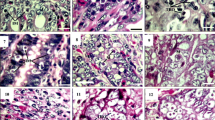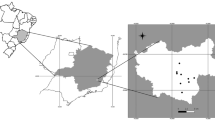Summary
Two Brown Rats (Rattus norvegicus) were experimentally infected with the Intestinal Fluke, Isthmiophora melis. 29% of the metacercariae fed to them developed into the adult or pre-adult stage. In former experiments with white laboratory rats not more than 10% of the metacercariae developed into the adult or pre-adult stage. The flukes from the Brown Rats correspond with the modification from the white rat. Thus, the synonymity of Echinostoma spiculator Dujardin (1845) with Isthmiophora melis Schrank (1788) is confirmed.
A wild Brown Rat from a South German lake was found naturally infested with Isthmiophora melis.
Zusammenfassung
Zwei Wanderratten (Rattus norvegicus) wurden experimentell mit dem Darmegel Isthmiophora melis infiziert. 29% der verabfolgten Metacercarien entwickelten sich zu Adulten oder Adolescarien, während bei früheren Versuchen mit weißen Ratten die Ansitz-Quote nur 10% betrug. Die gewonnenen Würmer entsprechen der Entwicklungsmodifikation von Isthmiophora aus der weißen Ratte. Die Synonymität von Echinostoma spiculator Dujardin (1845) mit Isthmiophora melis Schrank (1788) ist dadurch verifiziert.
In einer Wanderratte des Federsee-Gebietes wurde eine natÜrliche Infestation mit Isthmiophora melis festgestellt.
Similar content being viewed by others
Literatur
Beaver, P. C.: Experimental studies on Echinostoma revolutum (Froelich), a fluke from birds and mammals. Illinois biol. Monogr. 15, 1–96 (1937).
Dönges, J.: Der modifizierende Einfluß des Endwirtes auf die Entwicklung des Darmegels Isthmiophora melis (Schrank, 1788). Zugleich ein Beitrag zur taxonomischen Klärung des Genus Isthmiophora Lühe, 1909 (Trematoda, Echinostomatidae). Z. Parasitenk. 29, 1–14 (1967).
— Der modifizierende Einfluß des Endwirtes auf die Entwicklung des Darmegels Isthmiophora melis (Schrank, 1788). II. Euparyphium suinum Ciurea, 1921, ein Synonym von Isthmiophora melis. Z. Parasitenk. 30, 179–184 (1968).
Übrige Zitate s. Literaturverzeichnis bei Dönges, 1967.
Author information
Authors and Affiliations
Additional information
Mit Unterstützung durch die Deutsche Forschungsgemeinschaft.
Rights and permissions
About this article
Cite this article
Dönges, J. Der modifizierende Einfluß des Endwirtes auf die Entwicklung des Darmegels Isthmiophora melis (Schrank, 1788). Z. F. Parasitenkunde 35, 169–172 (1970). https://doi.org/10.1007/BF00259994
Received:
Issue Date:
DOI: https://doi.org/10.1007/BF00259994




